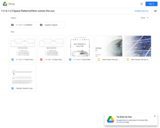
Google folder with Googles Slides and accompanying studnent journal files
- Subject:
- Professional Learning
- Science
- Material Type:
- Module
- Provider:
- Provo City School District
- Date Added:
- 10/08/2021

Google folder with Googles Slides and accompanying studnent journal files
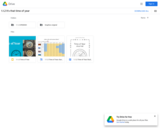
Google folder with Googles Slides and accompanying studnent journal files
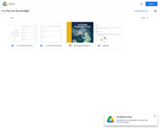
Google folder with Googles Slides and accompanying studnent journal files

Google folder with Googles Slides and accompanying studnent journal files
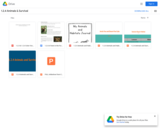
Google folder with Googles Slides and accompanying studnent journal files
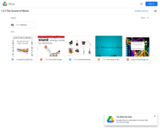
Google folder with Googles Slides and accompanying studnent journal files

Google folder with Google Slides and accompanying student journal files

21st Century Learning Design (21CLD) for Educators is a collection of eight modules. The learning path provides educators with clear and practical ways to develop 21st skills using digital technologies with their learners. 21st Century Learning Design for Educators builds on the research methodology providing a collaborative, practice-based process to help educators transform how they design enriching learning activities for their learners. The complete series of eight courses consists of videos, reading materials, rubrics for each dimension, and anchor lessons. Educators can actively participate by coding anchor lessons and redesigning their learning activities according to the 21CLD rubrics
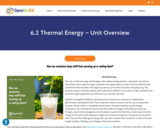
Unit Summary
This unit on thermal energy transfer begins with students testing whether a new plastic cup sold by a store keeps a drink colder for longer compared to the regular plastic cup that comes free with the drink. Students find that the drink in the regular cup warms up more than the drink in the special cup. This prompts students to identify features of the cups that are different, such as the lid, walls, and hole for the straw, that might explain why one drink warms up more than the other.
Students investigate the different cup features they conjecture are important to explaining the phenomenon, starting with the lid. They model how matter can enter or exit the cup via evaporation However, they find that in a completely closed system, the liquid inside the cup still changes temperature. This motivates the need to trace the transfer of energy into the drink as it warms up. Through a series of lab investigations and simulations, students find that there are two ways to transfer energy into the drink: (1) the absorption of light and (2) thermal energy from the warmer air around the drink. They are then challenged to design their own drink container that can perform as well as the store-bought container, following a set of design criteria and constraints.
This unit builds toward the following NGSS Performance Expectations (PEs) as described in the OpenSciEd Scope & Sequence: MS-PS1-4*, MS-PS3-3, MS-PS3-4, MS-PS3-5, MS-PS4-2*, MS-ETS1-4. The OpenSciEd units are designed for hands-on learning and therefore materials are necessary to teach the unit. These materials can be purchased as science kits or assembled using the kit material list.

The goals of OpenSciEd are to ensure any science teacher, anywhere, can access and download freely available, high quality, locally adaptable full-course materials. REMOTE LEARNING GUIDE FOR THIS UNIT NOW AVAILABLE!
This unit on weather, climate, and water cycling is broken into four separate lesson sets. In the first two lesson sets, students explain small-scale storms. In the third and fourth lesson sets, students explain mesoscale weather systems and climate-level patterns of precipitation. Each of these two parts of the unit is grounded in a different anchoring phenomenon.
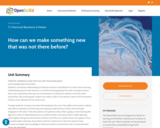
To pique students’ curiosity and anchor the learning for the unit in the visible and concrete, students start with an experience of observing and analyzing a bath bomb as it fizzes and eventually disappears in the water. Their observations and questions about what is going on drive learning that digs into a series of related phenomena as students iterate and improve their models depicting what happens during chemical reactions. By the end of the unit, students have a firm grasp on how to model simple molecules, know what to look for to determine if chemical reactions have occurred, and apply their knowledge to chemical reactions to show how mass is conserved when atoms are rearranged.
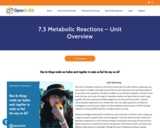
Unit Summary
This unit on metabolic reactions in the human body starts out with students exploring a real case study of a middle-school girl named M’Kenna, who reported some alarming symptoms to her doctor. Her symptoms included an inability to concentrate, headaches, stomach issues when she eats, and a lack of energy for everyday activities and sports that she used to play regularly. She also reported noticeable weight loss over the past few months, in spite of consuming what appeared to be a healthy diet. Her case sparks questions and ideas for investigations around trying to figure out which pathways and processes in M’Kenna’s body might be functioning differently than a healthy system and why.
Students investigate data specific to M’Kenna’s case in the form of doctor’s notes, endoscopy images and reports, growth charts, and micrographs. They also draw from their results from laboratory experiments on the chemical changes involving the processing of food and from digital interactives to explore how food is transported, transformed, stored, and used across different body systems in all people. Through this work of figuring out what is causing M’Kenna’s symptoms, the class discovers what happens to the food we eat after it enters our bodies and how M’Kenna’s different symptoms are connected.
This unit builds towards the following NGSS Performance Expectations (PEs) as described in the OpenSciEd Scope & Sequence: MS-LS1-3, MS-LS1-5, MS-LS1-7, MS-PS1-1, MS-PS1-2. The OpenSciEd units are designed for hands-on learning, and therefore materials are necessary to teach the unit. These materials can be purchased as science kits or assembled using the kit material list.
Additional Unit InformationNext Generation Science Standards Addressed in this UnitPerformance ExpectationsThis unit builds toward the following NGSS Performance Expectations (PEs):
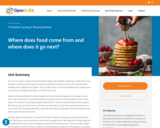
Students figure out that they can trace all food back to plants, including processed and synthetic food. They obtain and communicate information to explain how matter gets from living things that have died back into the system through processes done by decomposers. Students finally explain that the pieces of their food are constantly recycled between living and nonliving parts of a system.
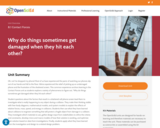
Oh, no! I’ve dropped my phone! Most of us have experienced the panic of watching our phones slip out of our hands and fall to the floor. We’ve experienced the relief of picking up an undamaged phone and the frustration of the shattered screen. This common experience anchors learning in the Contact Forces unit as students explore a variety of phenomena to figure out, “Why do things sometimes get damaged when they hit each other?”
Student questions about the factors that result in a shattered cell phone screen lead them to investigate what is really happening to any object during a collision. They make their thinking visible with free-body diagrams, mathematical models, and system models to explain the effects of relative forces, mass, speed, and energy in collisions. Students then use what they have learned about collisions to engineer something that will protect a fragile object from damage in a collision. They investigate which materials to use, gather design input from stakeholders to refine the criteria and constraints, develop micro and macro models of how their solution is working, and optimize their solution based on data from investigations. Finally, students apply what they have learned from the investigation and design to a related design problem.
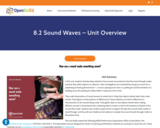
Unit Summary
In this unit, students develop ideas related to how sounds are produced, how they travel through media, and how they affect objects at a distance. Their investigations are motivated by trying to account for a perplexing anchoring phenomenon — a truck is playing loud music in a parking lot and the windows of a building across the parking lot visibly shake in response to the music.
They make observations of sound sources to revisit the K–5 idea that objects vibrate when they make sounds. They figure out that patterns of differences in those vibrations are tied to differences in characteristics of the sounds being made. They gather data on how objects vibrate when making different sounds to characterize how a vibrating object’s motion is tied to the loudness and pitch of the sounds they make. Students also conduct experiments to support the idea that sound needs matter to travel through, and they will use models and simulations to explain how sound travels through matter at the particle level.
This unit builds toward the following NGSS Performance Expectations (PEs) as described in the OpenSciEd Scope & Sequence: MS-PS4-1, MS-PS4-2. The OpenSciEd units are designed for hands-on learning and therefore materials are necessary to teach the unit. These materials can be purchased as science kits or assembled using the kit material list.

This module explores accessibility through several foundational concepts. Learn to create an inclusive learning environment through consideration of each accessibility principle.

Learn to teach with the accessibility tools in Windows 10, Office 365, and apps including Teams, Immersive Reader, Math Tools, Word, Translator, and OneNote. Dive deep into areas of student need to learn about specific opportunities and considerations for special education and online learning.
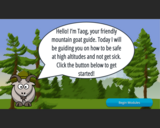
The learning modules are designed to heighten awareness of Acute Mountain Sickness and provide strategies to prevent and treat AMS. When one is exprienceing mountain sickness the best practice is to just go down! Note: These learning resources are for educational informational purposes only.

Noted Harvard scholar Henry Louis Gates, Jr. recounts the full trajectory of African-American history in his groundbreaking series The African Americans: Many Rivers to Cross. The series explores the evolution of the African-American people, as well as the multiplicity of cultural institutions, political strategies, and religious and social perspectives they developed — forging their own history, culture and society against unimaginable odds.
Using video clips from The African Americans: Many Rivers to Cross, this collection of lesson plans addresses a wide range of themes of the African-American experience from 1500 to the present.

Video segments are drawn from the animated documentary Dead Reckoning: Champlain in America which follows the French explorer Samuel de Champlain from his first contact with the indigenous people who taught him how to explore, chart and survive in the wilds of North America. The film was produced by Mountain Lake PBS and Montreal-based Artifex Animation Studios.